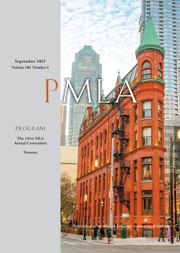No CrossRef data available.
Article contents
Reading Red, Reading Palestine
Published online by Cambridge University Press: 01 September 2025
Abstract
An abstract is not available for this content so a preview has been provided. Please use the Get access link above for information on how to access this content.
Information
- Type
- Theories and Methodologies
- Information
- Copyright
- © 2025 The Author(s). Published by Cambridge University Press on behalf of Modern Language Association of America
References
Works Cited
Abdaljawad Omar. “The Question of Hamas and the Left.” Mondoweiss, 31 May 2024, mondoweiss.net/2024/05/the-question-of-hamas-and-the-left/.Google Scholar
Abourahme, Nasser. “In Tune with Their Time.” Radical Philosophy, vol. 2, no. 16, 2024, pp. 13–20.Google Scholar
Abourahme, Nasser, and Day, Iyko. “Palestine after Analogy.” Critical Ethnic Studies, vol. 9, no. 1, 2024, https://doi.org/10.5749/CES.0901.01.Google Scholar
Bayoumi, Moustafa. “Exiled from Democracy? Arabs and Muslims and the 2024 US Elections.” Weissman Center for Leadership, 4 Dec. 2024, Mount Holyoke College.Google Scholar
Junior, Nyasha. “Saying ‘All Black Lives Matter’ Matters.” Dame Magazine, 22 June 2020, www.damemagazine.com/2020/06/22/saying-all-black-lives-matter-matters/.Google Scholar
Malm, Andreas. “The Destruction of Palestine Is the Destruction of the Earth.” Verso Blogs, 8 Apr. 2024, www.versobooks.com/blogs/news/the-destruction-of-palestine-is-the-destruction-of-the-earth.Google Scholar
Sexton, Jared. “Afro-Pessimism: The Unclear Word.” Rhizomes: Cultural Studies in Emerging Knowledge, no. 29, 2016, www.rhizomes.net/issue29/sexton.html.Google Scholar
Táíwò, Olúfémi O. Elite Capture: How the Powerful Took Over Identity Politics (and Everything Else). Pluto Press, 2022.CrossRefGoogle Scholar
Black, Too and Mowatt, Rasul A.. Laundering Black Rage: The Washing of Black Death, People, Property, and Profits. Routledge, 2014.Google Scholar

